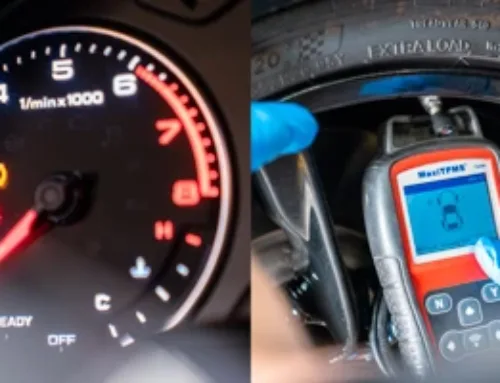Table of Contents
Have you ever taken a moment to look at the side of your tire? I mean, really look at it. You might be surprised to find that it’s covered in a series of numbers, letters, and symbols that might as well be in a foreign language. But this information on the sidewall can be important to make sure you’re using the right tires for your driving needs. Well, wonder no longer—we’ll show you how to read a tire sidewall and understand what that secret code means!
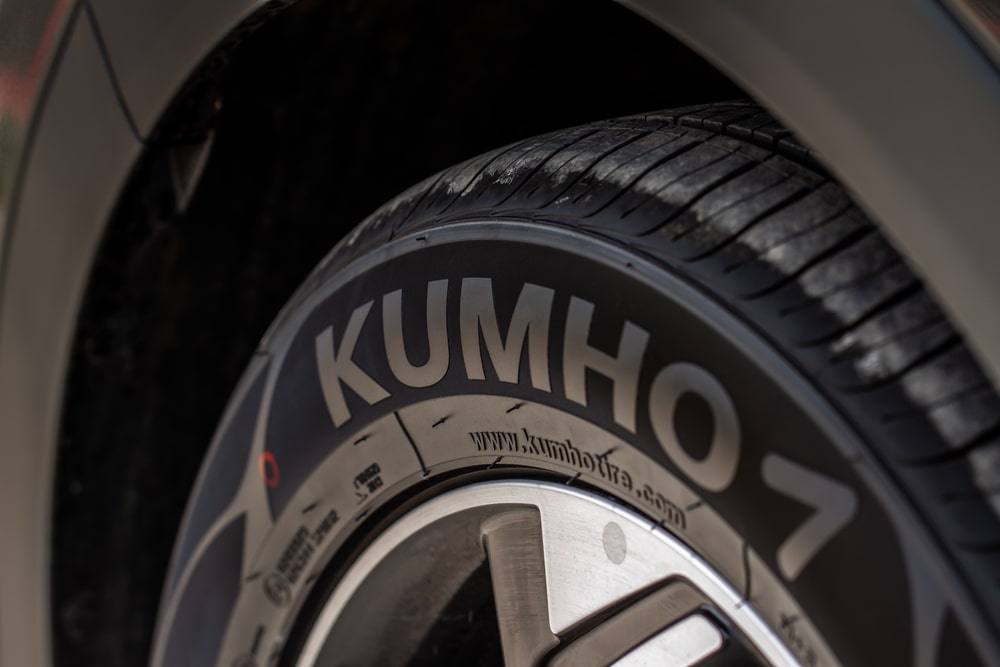
Tire sidewall basics
First things first, what is a tire sidewall? It’s the part of the tire that bridges the tread and the bead (the part that hugs the rim). The sidewall is covered with information, telling you everything from the tire’s size to its maximum load capacity, speed rating, and even when it was made! So let’s look into this information in a little more detail so you’ll be reading tire sidewall information like a pro in no time.
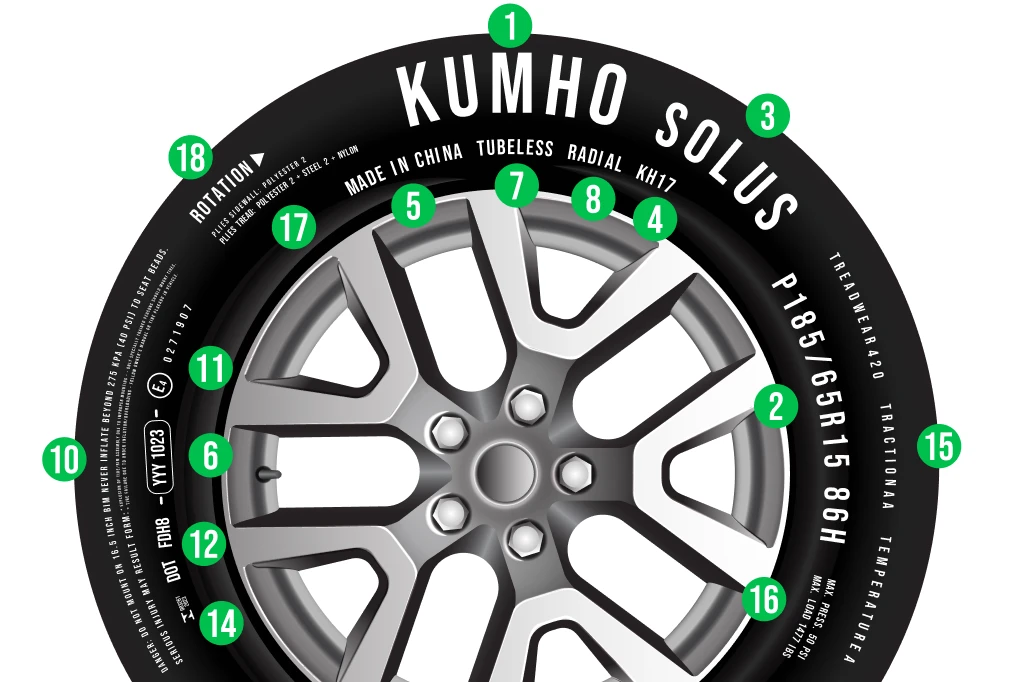
Who, what, and where?
Not everything on your tire is in a secret code. Some information is spelled out in plain English. For example, the tire manufacturer, the tire model, where the tire was made, and the type of tire. Here are some examples of information you’ll get clearly written out on your tire sidewall:
- Tire manufacturer: Kumho
- Tire model: Solus
- Tread pattern name: KH17
- Country of origin: Made in China
- Type of tire construction 1: Radial
- Type of tire construction 2: Tubeless
- Type of tire construction 3: Reinforced or Extra Load (for tires designed for higher loads and higher inflation pressures than standard tires)

Understanding tire size, speed rating, and load index
Now we get to some of the more obscure seeming information—including the tire size and width, which is usually displayed pretty prominently on the sidewall. It can appear in a few different formats, so let’s break them down for you.
Radial tires
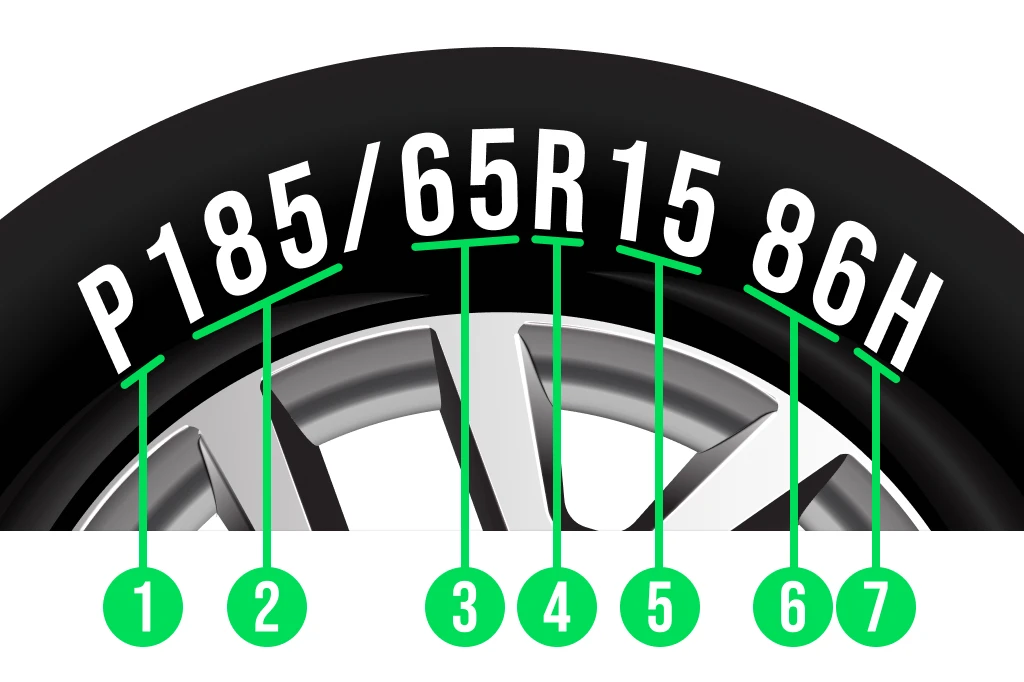
Most tires today are radial tires. They are made using ply cords that extend from the beads and run across the tread. Radial tires also often have a series of reinforcing belts (often made of steel) under the tread. If you have radial tires on your car, which you almost certainly do, you’ll probably find numbers and letters like this on your tire P185/65R15 86H:
- P, in this instance, stands for passenger tire—this will change for other types of tires. For example, a light truck tire will start with LT, and your temporary spare tire will have a T (so don’t drive on a T tire for too long).
- 185 is the tire’s width in millimeters. A wider tire provides more contact with the road, which can improve grip.
- 65 is the aspect ratio, which is the height of the tire’s sidewall as a percentage of its width. A lower number means a shorter sidewall, which can improve handling but may make for a bumpier ride.
- R shows the tire’s construction. In this case, R is for radial tires. Almost all modern tires are radial construction, although you may also find diagonal bias construction tires or belted bias tires.
- 15 is the wheel rim diameter in inches. This tells you the wheel size the tire is designed to fit.
- 86 indicates the load index, which shows how much weight the tire can support when properly inflated. The higher the number, the more weight the tire can carry. For passenger tires, this number usually ranges from 75 – 105, but it can go from 65 – 150 depending on the type of tire.
- H is the speed rating, which tells you the maximum speed capability the tire can safely maintain over time. This generally ranges from L – Y, with H oddly coming between U-V. An H-rated tire can perform up to 130 mph.
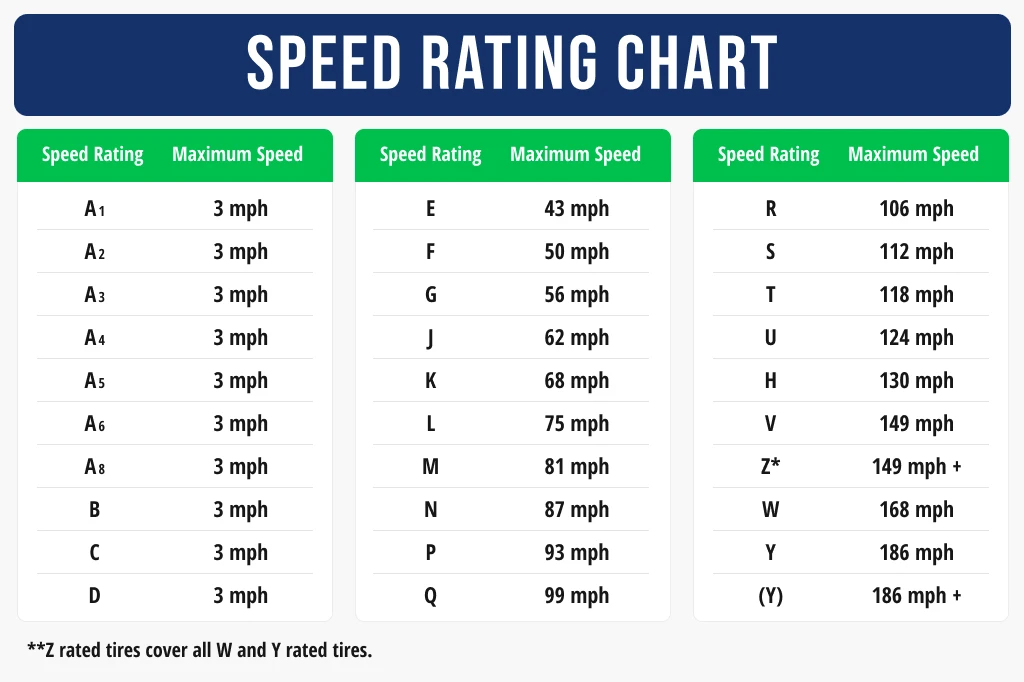
Another type of radial tire doesn’t include a letter at the start, for example, 225/40 ZR 18 92W:
- 225 is the tire’s width in millimeters. A wider tire provides more contact with the road, which can improve grip.
- 40 is the aspect ratio (%).
- ZR combines the speed category, with Z being up to 240 km/h, and the construction code, R, for radial.
- 18 is the wheel rim diameter in inches.
- 92 is the tire’s load index or how much weight it can carry.
- W is the speed rating.

Bias or cross-ply tire
Less common than radial tires are bias or cross-ply tires. They are constructed using layers of ply cords (typically made of nylon) that run diagonally toward the tire’s rotation direction. These layers crisscross over each other, hence the name “cross-ply.” If you have an off-road vehicle or vintage car, you might find you have bias tires. These tires have slightly different notation than radial tires. It might look like this: 6.45-13 4PR
- 6.45 is the width of the tire in inches.
- 2) – is the construction code for a bias tire.
- 3) 13 is the diameter of the rim in inches.
- 4) 4PR is the ply rating.
So, what is a ply rating? Like the load index on a radial tire, the ply rating tells you the maximum load limit and inflation limits of a bias or cross-ply tire when used in a specific type of service. While it might sound like it tells you how many cords (plys) your tire has, it’s actually a strength index, and the number of cords can vary. The load range part of a ply rating is generally shown by a letter (A, B, C, etc.), but you might also find Standard Load and Extra Load mentioned on your tire.
Your tire identification numbers (TIN)
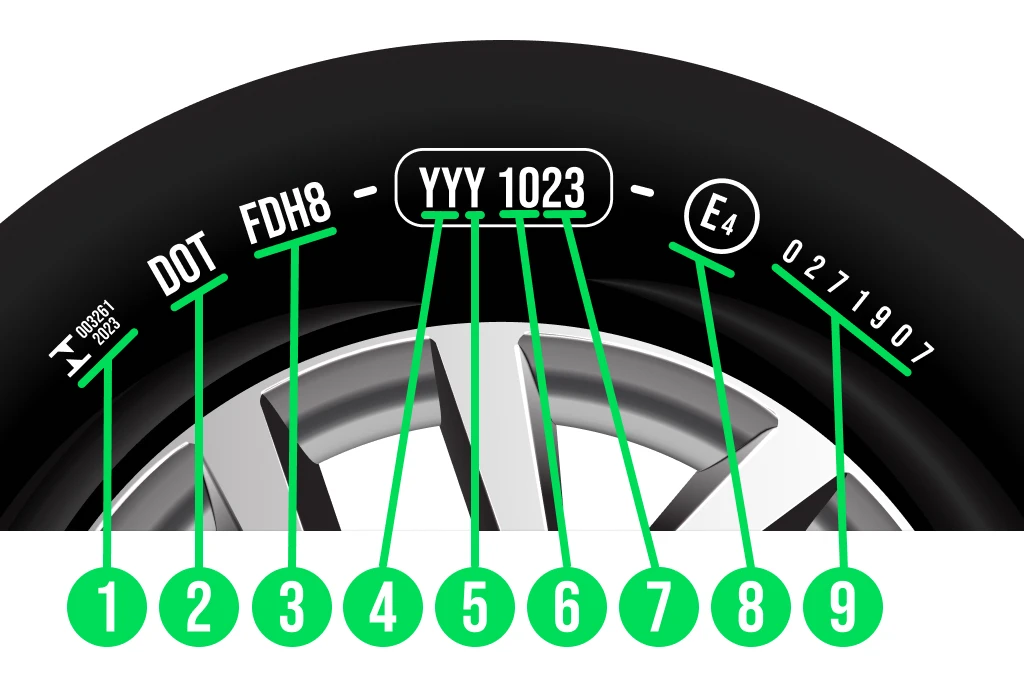
The Tire Identification Number (TIN) or Identification Serial Number comes after the letters DOT (Department of Transportation) and can contain up to 12 digits. This will be found on all tires made in the U.S. and tells you when and where your tire was made. The last four digits tell you when your tire was made. For example, 3520 was made in the 35th week of 2020. This number is important if there is a tire recall, so you know if your tire is faulty or not.
Safety warnings
Your tire sidewall might also have a few safety warnings. They might include things like:
- Serious injury may result from:
- Tire failure due to underinflation/overloading—follow the owner’s manual or tire placard in the vehicle
- The explosion of tire/rim assembly due to improper mounting—only specially trained persons should mount tires
- Danger: Do not mount on 16.5-inch bim
- Never inflate beyond 275 kPa (40psi) to seat beads
UTQG or tread wear ratings
Another important piece of information you’ll find on a tire is its UTQG rating. This rating is required by the government, but the testing is all carried out by the tire manufacturer. A UTQG rating gives you an idea of how long a tire will last based on treadwear, traction, and temperature grade. These three elements all contribute to the longevity of your tire. An example UTQG might be A AA 300
Treadwear
The number indicates the tread wear rating or how durable your tire’s tread is. Your tire has been tested against an industry-standard reference tire. The reference tire is rated at 100, so if your tread wear rating is 300, your tire should last three times as long as the reference tire.
Traction
The first letters before the number indicate your tire’s traction or how well it can stop on a wet test track. This measurement is only done with straight-ahead, wet braking on concrete and asphalt and doesn’t consider cornering or other road surfaces. Traction is measured with four levels from AA to C. AA means the tire performed very well on both concrete and asphalt, while down at C, the tire performed poorly on either one or both of the surfaces.
Temperature resistance
You may also get a letter from A to C for temperature resistance, with A being the best. This measures how heat-resistant the tire is in normal driving conditions. Things like excessive speed, overloading a vehicle, and underinflation of your tires can all cause excess heat to build up. If your tire is exposed to high temperatures regularly, it may not last as long.
Other markings
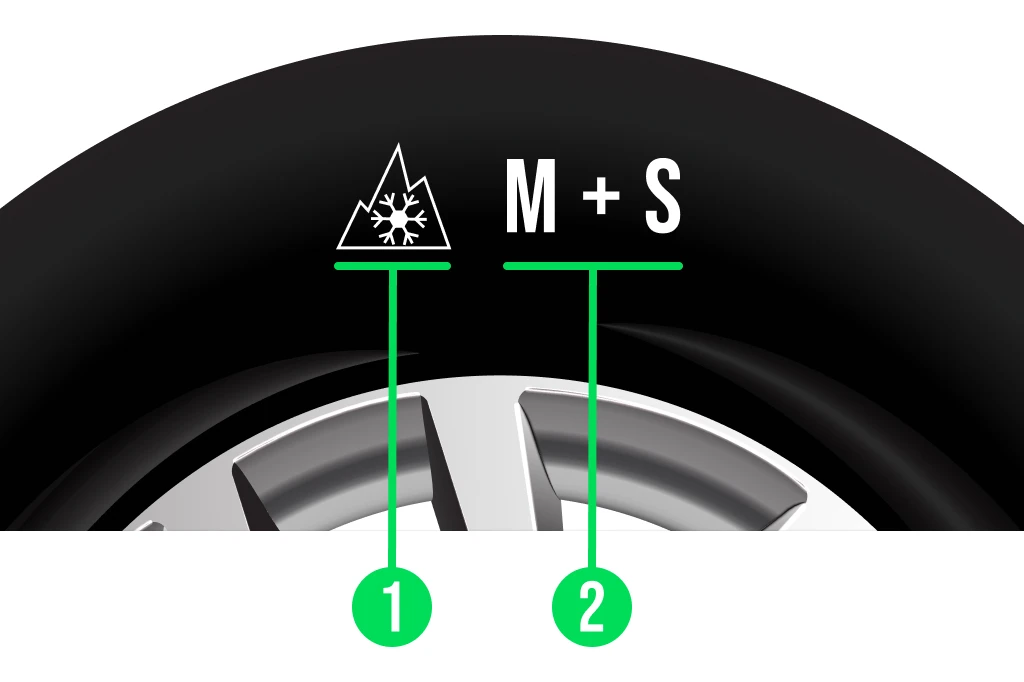
There are also a host of other markings on the sidewall. Here are a few common ones:
- M+S (MS, M/S, or M&S), which stands for Mud and Snow, shows tires that can be driven in light mud and snow.
- Three peak mountain or snowflake symbol indicates tires that are rated for winter driving.
Extra markings
- DOT Mark indicates that tires comply with U.S. Department of Transportation safety standards.
- ECE Mark shows compliance with ECE (Economic Commission for Europe) regulations for European tires.
- CCC mark works the same for compliance with China Compulsory Certification for Chinese tires.
- Safety warnings may also be present on your tire, including information on suitable rim sizes and over and under-inflation warnings.
- Max. Load and Max. Press. It shows the maximum weight the tire can carry and the maximum air pressure you can inflate it. For example, you might see Max. Load 1477 lbs and Max Press. 50 psi
- Construction details will show the materials used and the tire’s composition. For example Plies, Sidewall: Polyester 2, Tread: Polyester 2 + Steel 2 + Nylon
You might also find some more practical marks showing the rotation direction as well as the triangle marks showing where the tread wear indicators are in the grooves of the tread. The tread wear indicators are set to 1.6mm of remaining tread, and when they show that only that is remaining, you should replace your tire.
Frequently Asked Questions
How do you read the sidewall of a tire?
Reading a tire sidewall may seem tricky, but when you know the basics, it’s easy. You’ll see a few words you recognize, like the tire make and model. The most essential tire information on the sidewall for you to understand is the tire size, speed, and load ratings, which look something like 205/55R16 91V.
- 205 is the tire’s width in millimeters,
- 55 is the aspect ratio (the height of the tire’s sidewall as a percentage of its width),
- R stands for Radial (the tire’s construction)
- 16 is the diameter of the wheel in inches
- 91 is the load index (the weight the tire can carry)
- V is the speed rating (the maximum speed you should use the tire at)
You’ll also find a Tire Identification Number, which starts with DOT and tells you when and where the tire was made. Other markings like M+S indicate the tire’s suitability for driving in mud and snow.
What do the numbers on the sidewall mean?
The numbers on the sidewall tell you the tire size, the weight it can carry, and how fast it can go. Let’s take 195/60R14 as an example. 195 is the width of the tire in millimeters, and 60 is the aspect ratio, which tells you the height of the tire’s sidewall as a percentage of its width. The R stands for Radial, indicating the tire is of radial construction, and 14 is the diameter of the wheel in inches, so this tire is designed to fit a 14-inch wheel. You might also see something like 87W – 87 is the load index, telling you the load limits the tire can carry, and W is the speed rating, indicating the maximum speed the tire can safely handle. To find more information on this, you can check a load index chart and speed rating chart. So, those numbers are pretty significant— they’re the key to understanding your tire’s size, load capacity, and speed capability. So, now you know how to read tire sidewall like a pro!









